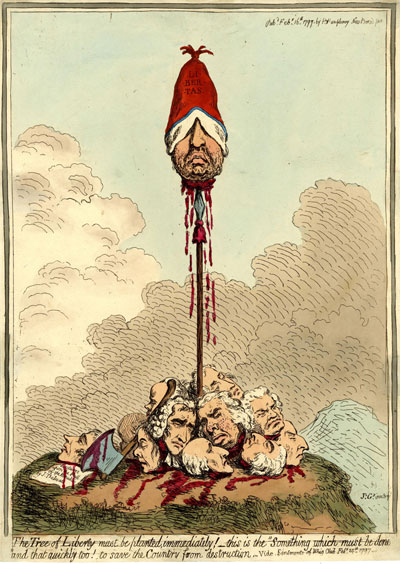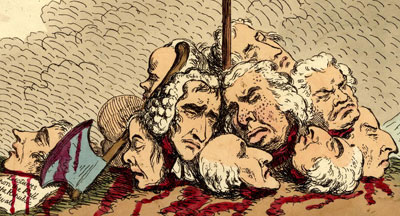The Tree of Liberty Must be Planted Immediately!
Like the bonnet rouge, the tri-colour cockade, the plain workman's trousers (sans-culottes), and the carmagnole, the tree of liberty was one of the principal symbols of the French Revolution. After France announced to the world in the Decree for Proclaiming the Liberty and Sovereignty of all Peoples (1792) that it would be the chief propagator and supporter of liberty, equality and fraternity across Europe, liberty trees were planted whenever a new insurrection announced French values or whenever French forces occupied a new region. As the British Museum commentary notes, the "tree" was not always a literal tree, but sometimes a kind of maypole around which revolutionaries gathered and/or danced as in the frontispiece to Hollandia Regenerata.

© Trustees of the British Museum
During 1796 and 1797 as the French forces, led by the young Napoleon attacked Italy, English readers would have heard of Liberty trees being set up in Milan and Mantua. And closer to home, they could have read in the London Times (January 3, 1797) of the French officer captured after an abortive attempt to land troops in Ireland who had expected that the Irish
were in a state of insurrection; and they hoped, if they [the French] could effect a landing, to see the Tree of Liberty immediately planted.
And even more recently, Gillray's audience could have read in the True Briton (January 20, 1797) that the Minority Electors of Southwark celebrated a recent victory in committee with the following three toasts:
The Rights of Man
May the People never forget that their Rights depend upon themselves.
May the Tree of Liberty extend its branches to every part of Europe.
After the French invasion of Ireland, the continued support of the revolution by radical Whigs like these must have seemed to Gillray the final straw. The Tree of Liberty Must be Planted is arguably the most brutal and violent print Gillray ever produced, pointedly turning around a toast supposedly given at a recent Whig Club Meeting, and directing it against the Whig leadership itself.* Proudly signed as invented and produced by Gillray, Tree of Liberty Must be Planted Immediately insists, in effect, that the preservation of the country depends upon the violent execution of the best known members of the Foxite branch of the Whigs.
In the center of the print, the decapitated head of the Whig leader Charles James Fox appears dripping with blood from the top of a pike.** He wears a bonnet rouge with the word "Libertas" emblazoned across it. At the foot of this Tory version of a liberty tree are more decapitated heads of the Whigs whom Gillray thought were the most dangerous. All of them but one unidentified by other clues.

© Trustees of the British Museum
But not surprisingly, since all of them would have been Francophiles, most had appeared in earlier Gillray prints. And many were also portrayed a year later in the robes of French functionaries in Gillray's series French Habits. Comparing the heads in The Tree of Liberty with these roughly contemporaneous portraits helps confirm their identities. They include from left to right:
- John Thelwall. This provocative lecturer appeared in Gillray's earlier print, Copenhagen House (1795). In 1794, he had been tried and acquitted for high treason. As perhaps the least well known of the Whigs featured here, Gillray includes a paper next to his head inscribed with "Lectures upon the Fall of the Republic by J. Thelwall."
- The Earl of Derby (barely visible in the shadow). To fans of Gillray, Derby is better known for his liaison with the actress Elizabeth Farren, but he was also included whenever Gillray needed an extra Whig to attack. But he is given a more prominent role as a member of the French Council of Five Hundred in Gillray's French Habits #3.
- The Earl of Lauderdale. A vocal opponent of Pitt's policies and especially the war with France. Lauderdale had appeared in Gillray's Patriotic Regeneration (1795) standing behind the accused Pitt with an executioner's axe in one hand and the noose around Pitt's neck in the other. But like Derby, he also appears in French Habits #3.
- George Byng. A Whig MP for Middlesex, Byng was a loyal follower of Fox (he paid off some of Fox's debt in 1794). A year earlier he had appeared in Gillray's A Hackney Meeting (1796). Later, along with Derby and Lauderdale, he appears as the tallest member of the French Council of Five Hundred in Gillray's French Habits #3.
- Thomas Erskine (still wearing his lawyer's wig). The egotistical Erskine was the principal barrister for Whig causes—famous (or infamous) for successfully defending John Thelwall, Thomas Hardy, and Horne Tooke in their trial for high treason. Later, he appears as the Advocate of the Republic in French Habits #7.
- Earl Stanhope. The Earl was famous (and much ridiculed by his peers) for declaring himself a sans-culotte in the House of Lords. (1794). As a result, he had appeared in Gillray's 1794 broadside The Noble Sans-Culotte, and again without breeches as the father of the bride in Gillray's wonderfully fanciful Democratic Leveling (1796).
- Richard Brinsley Sheridan. With his playwright's gift for a memorable phrase, Sheridan was perhaps the most brilliant spokeman for Whig principles, and had appeared in Gillray's work almost as often as Fox himself. In Democratic Leveling (1796), he was portrayed along with Fox and Stanhope with a copy of Thelwall's Lectures in his hand. And like most of the other Whigs in The Tree of Liberty, he also appears in French Habits #5.
- George Tierney. Located just above Sheridan, this is the only head whose identity is really in doubt. A youngish-looking man, he has been variously identified as John Wilkes by Wright and Evans, Sir Cecil Wray by Grego, and Charles Grey by the British Museum. I think it is safe to assume that any possible candidate in addition to being somewhat young would likely appear in other contemporaneous Gillray prints. That would immediately rule out Wilkes, who would have been in his seventies in 1797 and seldom appears in Gillray's prints at all. It would also make Sir Cecil Wray at age 43 somewhat unlikely choice and especially when compared to Wray's appearance in The Hopes of the Party Prior to July 14th where he can be conclusively identified by the "Plan of Chelsea Hospital" in his pocket and the cask of "Small Beer" in his arms. Charles Grey at 33 in 1797 was young enough to be the mystery head, and he was beginning to be portrayed as a fierce attack dog among the Whigs. But in the few instances where he is clearly identified (for example, in Parliamentary-Reform), his caricature portrait does not much resemble the decapitated head. Among young Whigs significant enough to be included with the other decapitated heads (though not mentioned by any of the most trusted Gillray commentators), are two more that could be considered: Sir Francis Burdett and George Tierney. Both of them appear in multiple prints around 1797/98 and, perhaps most importantly, both appear in French Habits along with most of the other Whigs. Unlike the mystery head, however, Burdett, is characterized by his prominent hair and curved nose. That leaves as the most likely alternative, George Tierney, whose age (36) and prominence among Whigs meet the criteria. And his straight nose, small mouth, and heavy eye brows in The Explanation and French Habits #6. bear at least some resemblance to the features of this head.
- Michael Angelo Taylor (at the bottom of the pile facing upward). After 1784 when Taylor switched from Tory to Whig, and his house in Whitehall became a meeting place for the Whigs, the diminutive Taylor began appearing in Gillray prints as a consistent supporter of Fox, including in The Westminster Hunt (1788), The Dagger Scene (1792), The Presentation, or The Wise Men's Offering (1796) and French Habits #3. (1798)
- Horne Tooke. Along with John Thelwall and Thomas Hardy, Tooke was arrested, and tried for high treason for his support of radical reforms to Parliament. Gillray portrayed him in The Hopes of the Party Prior to July 14th holding the King's legs in an obscene pose while Fox prepares to chop off the King's head. the King. Later, in French Habits #5, he appears as President d'Administration Municipale.
- George Hanger. More of a friend and drinking companion to Fox and the Prince of Wales than a political figure, most of Gillray's portraits of Hanger occur in social situations like Georgey a' Cock-Horse.
* I have searched through a lot of British newspapers in the months of January and February, but I have been unable to find one that repeats this toast.
** Among the not-yet-digitized dawings by Gillray in the British Museum is this one which was likely a study for Fox's head in The Tree of Liberty Must be Planted Immediately!
Sources and Reading
- Commentary from the British Museum on The Tree of Liberty Must be Planted Immediately!.
- "Symbolism in the French Revolution," Wikipedia
- "War of the First Coalition," Wikipedia
- "George Byng," History of Parliament
- "Charles James Fox," Wikipedia
- "Richard Brinsley Sheridan," Wikipedia
- "Edward Smith-Stanley, 12th Earl of Derby," Wikipedia
- "James Maitland, 8th Earl of Lauderdale," Wikipedia
- "John Horne Tooke," Wikipedia
- "Thomas Erskine, 1st Baron Erskine," Wikipedia
- "John Thelwall," Wikipedia
- "George Hanger, 4th Baron Coleraine," Wikipedia
- "Michael Angelo Taylor," History of Parliament
- Thomas Wright and R.H. Evans, Historical and Descriptive Account of the Caricatures of James Gillray #162.
- Thomas Wright and Joseph Grego, The Works of James Gillray, the Caricaturist; With the History of His Life and Times, p. 218-19.
Comments & Corrections
NOTE: Comments and/or corrections are always appreciated. To make that easier, I have included a form below that you can use. I promise never to share any of the info provided without your express permission.